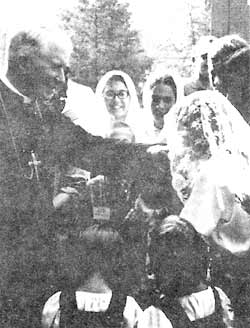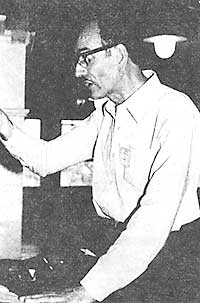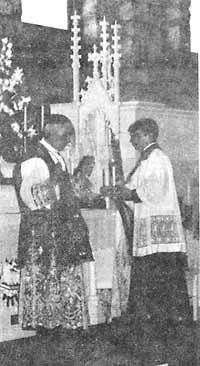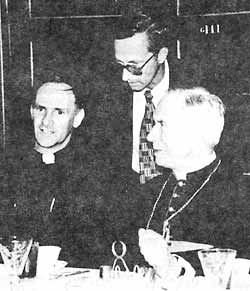Days to Remember
The Angelus Pilgrimage to Saint Mary's
during August 1979
Text of articles written by Dorothy N. Hoobler
Photographs by Belinda Parnell
both of The Saint Marys Star
|
Archbishop Lefebvre arriving at Saint Mary's on Monday, 13 August, being greeted by the Miller family. |
"I won't be able to be there. Please, won't you write about the Pilgrimage in detail? Then I can at least read about it." This article is the first part of my response to that request for an in-depth description of the August 13–16 events which are being held on the St. Mary's College campus. The Pilgrimage, which includes masses, seminars, sermons, confirmation, confession, and the cornerstone-laying ceremony, will be highlighted by the visit of Archbishop Marcel Lefebvre, founder of the Society of St. Pius X. He will offer the Pontifical High Mass at 11 a.m. Wednesday, August 15—the day of the Feast of the Assumption.
For over a year, the members of the Society have worked feverishly to ready the decaying buildings and the neglected grounds for the visit of the Archbishop from Econe, Switzerland. Plans took a gigantic setback in November of 1978, when the interior of the magnificent Immaculata Chapel was gutted by fire. Undaunted, a "We will rebuild" refrain seemed to buoy the hopes and dreams of the parishioners who have come from so many states to make their home in St. Marys. With the opening of the St. Mary's Academy in September, many other families are expected to move into the community.
All the additional work and worry involved in the frantic rush to have the new Assumption Chapel ready for the Mass, and the bustle of converting the old gymnasium into a dining hall to serve over 1,000 people, has kept the local congregation working from dawn until dark. Others in the St. Marys area have also been involved with preparations. The Continental Telephone Company, for example, has installed ten extra telephones. Visiting parishioners can call their families back home and brag about the lovely Kansas weather this past weekend. The members of the press and other news media will also be calling in their reports of Pilgrimage activities. A press conference will be held on Wednesday morning, and that should stir up lots of excitement.
The Holladays and the "Star" staff have made a contribution to the press packet. The kit contains the special issue, "St. Mary's College," with the stories of the 131-year history of the institution as well as the vivid, chilling pictures and accounts of the Immaculata fire. The packet, in addition to the color-coded press pass which will be a necessary "ticket" to cover the activities, also has pictures and fact sheets about the Archbishop, Society director Father Hector Bolduc, author Michael Davies, and Academy director Herman Belderok.
|
Londoner David Read whose expertise and beautiful bass voice added so much to the beauty of the Pilgrimage. |
Contributing to the impressiveness of the Mass are the floral arrangements for the altar. It's impossible to see the beauty of a flower and still question the power and majesty of the Creator.
The St. Mary's College campus looked beautiful as guests began arriving early on August 13. I was impressed by the numbers of family groups, grandparents, parents, and well-behaved children of all ages.
The early-day Jesuits would have been surprised to find a sand pile and swing sets in constant use behind Coppens Hall. Men and women alike followed the suggested dress code, and robed priests, nuns and brothers in full habit also toured the grounds. The weather Monday morning was absolutely beautiful. Although the sun was bright, the breeze was cool and refreshing. The small gym (it was once the domain of the younger men at old S.M.C., was a beehive of activity. One side was set up as the snack bar, with breakfast and lunch being served cafeteria style. Even the young folks did their share of work, helping serve and clear the tables.
The center of the gym was transformed into a bookstore with all kinds of literature, rosaries, medals, and missals as well as the St. Marys Chamber of Commerce brochures and copies of "St. Mary's College." The Angelus Press, Dickinson, Tex., even assembles its own religious greeting cards. In the display from TAN Publishers, Illinois, I was interested to find The Church Teaches, Documents of Christ in the English Translation, written by the Jesuit Fathers of St. Mary's College. The volume was dedicated to Reverend Gerald Van Ackeren, S.J. who conceived the idea and interested the Jesuits in collaborating the work." Several area businesses also had booths since so many families plan to move into the area, their representatives were available to answer questions.
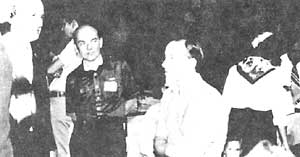
Author Michael Davies conversing with admirers in the Convention Center.
People stopped by the St. Marys Star table to visit, including author Michael Davies, whose new book, Apologia Pro Marcel Lefebvre, was released for sale here. He is an interesting man, much younger than I expected for one who has authored so many books. He perched on the edge of the table, graciously autographing copies of his books and answering all kinds of questions from admirers. The conversations were fascinating, covering a wide range of topics from the changes in the Catholic Church and historical events in Europe to socialized medicine in England and his opinion of St. Marys. "It's very much like England, with the shops within a five-minute walk. It's the only place I've seen in America where I'd really want to live,'' he added. Mr. Davies talked about the beauty of the Pontifical High Mass with its traditional hymns and vestments, and the movements which are an art form, almost as if they are choreographed, he said. "The Mass is the same Mass observed in 604 by St. Gregory the Great. The plain chant is even more ancient, going back to the Jewish synagogue rituals." As listeners from Norway, New Mexico, and Florida nodded in agreement, he commented, "This is surely one of the greatest cultural events ever to take place in Kansas. It's a step back into history." From the smiles on their faces, it was obvious that they were pleased to have a part in this historical event.
Mr. Davies suggested that I attend the choir seminar while they practiced in Assumption Chapel. He translated the words from the Latin as David Read of London sang the Gloria Patri and the choir voices joined in beautiful harmony. Quietly, parishioners entered the chapel, knelt and sat down to meditate and pray as they listened to the age-old hymns. Surely the Pontifical High Mass will be an experience to remember.
The Pilgrimage...
|
His Grace celebrating Holy Mass |
|
When Archbishop Lefebvre arrived on the campus to lead the 5 p.m. Mass on August 13, the crowd which greeted him was both large and enthusiastic. It was possibly the largest gathering of people on campus since the November 1978 Immaculata fire. Then, the feeling of despair was a black as the smoke which poured through the gutted windows. This time, the mood was of warmth and devotion. Television cameras filmed his greetings to the pilgrims. The Archbishop is a gray-haired man of 73 with a kindly smile which belies the words so often used to describe him. Many news reports used terms like "rebel," "controversial," and "maverick" because of his role in the conflict within the Church since the Vatican II Council. The members of the Society of St. Pius X obviously disagree, and repeated their display of affection with a prolonged and rousing acclamation when he arrived at the evening banquet hall.
Approximately 450 people attended the dinner which was catered by Ballinger's of Augusta, Ks. Their vans, loaded with the hot and delicious food, made the trip with the meal already prepared for serving. I didn't even want to ask how many hundreds of meatballs it took for all that spaghetti! The banquet was billed as a "get acquainted dinner," and from the steady buzz of conversation, the diners must have enjoyed the fellowship as well as the food.
Tuesday's weather was cold and rainy, proving the truth in the cliche, "if you don't like Kansas weather, just wait a day or two. It will change." Even the steady drizzle didn't seem to dampen the enthusiasm of the conferees, who continued their seminars, lectures, and choir practice. Once again, director David Read led the practice for the Pontifical Mass and the Vespers. Mr. Read, a Londoner, has sung as a bass soloist with the London Symphony and BBC Philharmonic Orchestra. Pointing our various passages which I'd heard them rehearse, he explained the difficulty in reading the music of the Gregorian chant. The notes are square, because the music was written in the days of quill pens. Few of the Latin chant hymnals are still in existence, except for those in university libraries or laying forgotten in dusty, unused church music cabinets, he said. Mr. Read also composed one portion of the High Mass and it was sung here for the first time in public. The Vespers on Tuesday brought a flood of memories for the older worshippers. Vespers—even the word seems to convey a feeling of calm rest and a peace with one's self and with God.
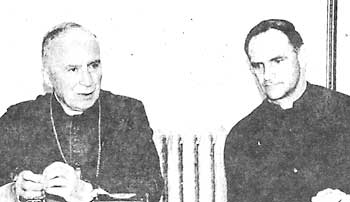
Archbishop Lefebvre and Father Bolduc at the Wednesday press conference
The press conference was scheduled for early Wednesday morning and author Michael Davies briefed us on the life of Marcel Lefebvre shortly before his arrival. Lefebvre makes a striking appearance: the richness of the colors of his robe accents his fair complexion and blue eyes. The questions were direct with no punches pulled, and the answers were just as frankly given. Although the Archbishop does speak English, he usually answered in French and Father Hector Bolduc acted as translator. Yes, "The relationship with Pope John Paul II is cordial. He is resolved to find a solution." He explained that one man, not a committee, is acting as intermediary with the Pope, and the latest direct meeting was on June 25. "We are awaiting word from the Pope on the use of the Latin Mass," he said with a hopeful smile. No, the Pope did not condemn the ordinations of the 34 priests at Ecône in June, and the fact that he made no comment is considered promising. Yes, the seminary established at Ecône was considered a valid one by the Church, otherwise, he pointed out, why would Rome have bothered to condemn it later?
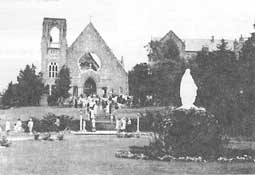 |
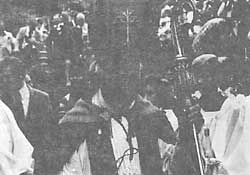 |
| On August 15th, His Grace officiated at the laying of the cornerstone for the rebuilding of the Immaculata Chapel which burned in a tragic fire in November 1978. Over 1,000 people were present when he applied a trowel full of mortar to the 300 pound piece of Kansas sandstone which was prepared by the Bayer Stone Co. of Saint Marys. Placed in a sealed container with the cornerstone were papers and documents pertaining to the Society of St. Pius X and St. Mary's College, medals, coins and other artifacts, including a current copy of THE ANGELUS. After the blessing of the stone Archbishop Lefebvre called upon two workmen from Saint Mary's—Karl Stromberg from California and Albert Gonzalez from Texas—to assist him in setting the stone in place. | |
The documents, letters, and conversations between Pope Paul VI and Marcel Lefebvre are listed in chronological order in the Davies book, Apologia Pro Marcel Lefebvre, or called Apologia in the shortened version of the title. Davies elaborated on many of the answers to the questions, and then continued his explanations in his lecture after the banquet. He pointed out that the liturgy the traditionalists use was not banned by the Vatican II Council. It is the later interpretation of the "spirit of Vatican II" which has created the conflict, he charged. Pointing out their objections to the ecumenical movement, Davies said with complete candor, "Traditionalists are not anti-Protestant, but they believe in what they believe and they should say so honestly."
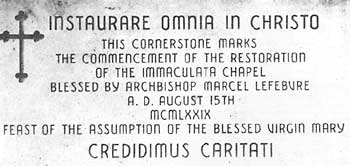
Two great mottos are combined on the cornerstone:
Instaurare omnia in Christo "To restore all things in Christ," the motto of Pope St. Pius X,
and Credidimus caritati, "We have believed in charity," the motto of Archbishop Marcel Lefebvre.
Following the press conference, the Archbishop joined the procession formed for the cornerstone-laying ceremony at the Immaculata Chapel. They slowly proceeded up the steps past the gaping holes which revealed the burnt-out sanctuary with its Italian marble altars carefully sealed against the elements, It was a moving ceremony, an expression of faith in the future of St. Mary's College and in the rebuilding of the Chapel.
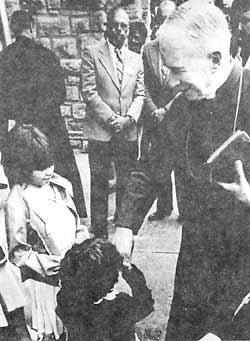 |
The transformation of Canisius Hall into Assumption Chapel seemed like a small miracle, and it was filled to overflowing. When the hundreds of chairs were quickly occupied, the worshippers stood. The altars were decorated with masses of lovely flowers and tall white tapers in golden candlesticks. The unusual painting, the Icon of Kiev, was also accented with a bouquet of roses and carnations. The simplicity of the faces of the Madonna and Child contrasted with the elaborate brass halo and the ornate frame. And there was the huge Bishop's Chair, the one that had been a part of St. Mary's College history for so many years. Above it was the red and gold canopy and the shield with the Archbishop's coat of arms.
The Mass began. How can you adequately describe the pageantry, the vivid colors of the vestments and the bishop's mitre; the brace and beauty of the movements of the ritual; the pungent smell of the incense; the melodious sound of the ancient chants and hymns; the solemn faces of the altar boys; and the look of devotion on the rapt faces of reverent worshippers? In his sermon, delivered in French and then translated, the Archbishop reaffirmed the desire to rebuild the chapel. For the Feast of the Assumption message, he used scripture passages to point out that Mary is the example and teacher of the faith. Holding the golden staff in his left hand, he charged the congregation to be "the leaven of the Church." Communion was distributed first to the children making their First Holy Communion, and then to the huge crowd of believers. The Mass ended.
|
Dave Gayner, Business Manager of St. Mary's College, with Father Bolduc and Archbishop Lefebvre |
At the closing banquet, attended by approximately 1,200, Father Bolduc expressed his thanks to so many who helped to make this first pilgrimage such a success. Appreciation was also extended to the city and to the residents of St. Marys for their co-operation this past year. Archbishop Lefebvre will take back to Ecône a beautiful picture of the Immaculata as it was when he first saw it two years ago. He also carries with him a cordial invitation to return again soon for the dedication of a rebuilt chapel. The activies on the Feast of the Assumption ended with Confirmation, a candlelight procession, and the Benediction. The first pilgrimage ended Thursday with hourly masses and prayers of gratitude.
This has been a week for intense and mixed feeling. For the members of the Society, it has been a joyous time, a dream come true, the answer to a prayer. For the more than 2,000 who made the pilgrimage from all over the world, it has been a time of renewal and hope.
